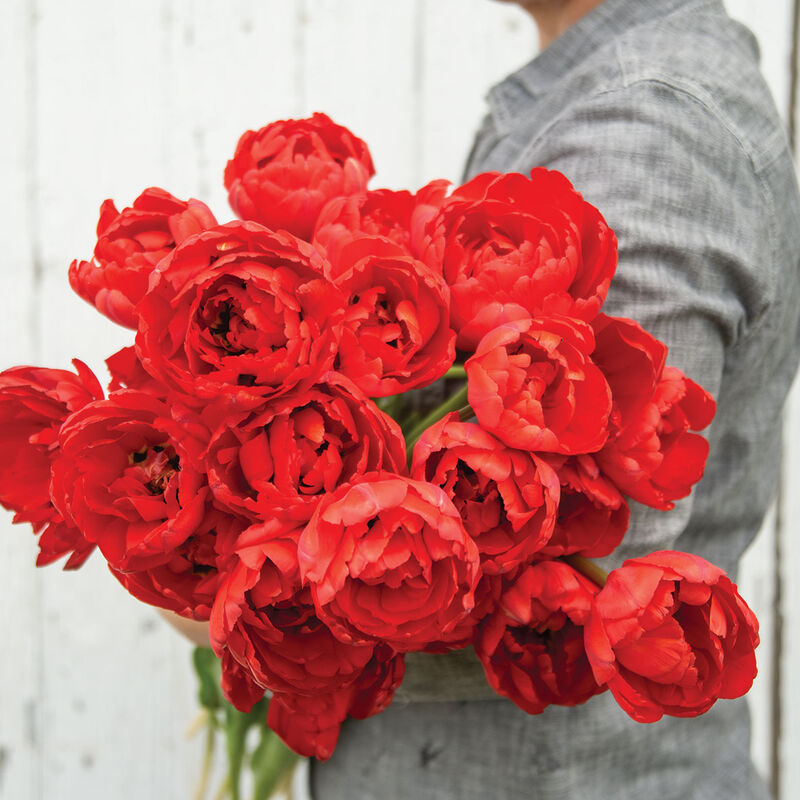Miranda Tulip Bulb
Miranda Tulip Bulb
Cheerful and early.
One of the earliest doubles to flower in our trials. Though classified as a Double Late tulip, Miranda's lineage is from the Darwin Hybrid group, making her early, tall, and uniform. Her round, "pom-pom like" buds open to deep vibrant red, fully double 3" blooms. NOTE: Bulbs do not come pre-chilled; if growing in hardiness Zones 8–10, see growing information (below) for pre-chilling instructions.Specs:
- This product does not ship to Canada.
- This product does not ship to the following countries: United Arab Emirates, Austria, Australia, Barbados, Belgium, Bulgaria, Bermuda, Bahamas, Switzerland, Cyprus, Czech Republic, Germany, Denmark, Estonia, Spain, Finland, France, United Kingdom, Greece, Hong Kong, Croatia, Hungary, Ireland, Iceland, Italy, Japan, Republic of Korea, Kuwait, Cayman Islands, Lithuania, Luxembourg, Latvia, Malta, Netherlands, Norway, New Zealand, Oman, Poland, Portugal, Qatar, Romania, Saudi Arabia, Sweden, Singapore, Slovenia, Slovakia, San Marino, Thailand, Trinidad and Tobago, Taiwan, Ukraine.
- This product does not ship to the following states and jurisdictions: AA, AE, AP, AS, FM, GU, HI, MH, MP, PR, PW, VI.
This item’s size, weight, or shape may require an additional shipping surcharge based on the shipping location selected. Specific charges will be displayed during checkout.
Tulip and narcissus bulbs ship October through November.
DAYS TO GERMINATION:
Plant bulbs in the fall for spring blooms.SOWING:
Bulbs should be planted soon after arrival (or immediately after pre-chilling) and when the soil has cooled to 55°F (13°C) or cooler, and nighttime temperatures consistently drop to 40–50°F (4–10°C) but before the ground freezes. Planting about 5-6 weeks before the ground freezes allows the bulbs sufficient time for root development. Store Bulbs if you can't plant right away: If you cannot plant right away, you can store bulbs for up to a month by following these steps. Open all bags and boxes and place bulbs in a cool, dark, dry area (such as a root cellar, basement or garage), with good air circulation. You can alternatively store your bulbs in the refrigerator crisper drawer, but do not store them with ripening fruits; ethylene gas released by ripening apples and other fruits can cause the flower inside the bulb to abort or incompletely form. Temperatures of 38–65°F (3–18°C) are fine; the cooler the better, but do not freeze your bulbs. Note on Tulips in Hardiness Zones 8–10: Chilling during the bulb's dormant period is required for flower development. Johnny's does not currently offer prechilled bulbs. If you are located in Zones 8–10, you will need to prechill your bulbs at 38–45°F (3–7°C), for 6–12 weeks before planting. To prechill, leave bulbs in their bags and place in a refrigerator for up to 12 weeks. Be careful not to store bulbs near fruit, especially apples. Once bulbs have been chilled, plant them immediately, at the coolest time of the year. In Zones 9–10, because chilling does not naturally occur, bulbs will only bloom once, in the spring following planting of prechilled bulbs. Planting Bulbs: Loosen the soil to a depth of 8–12" to help ensure adequate root establishment. Adding a layer of compost to the root zone at planting will also aid in root establishment and plant growth. Press bulbs, upright, into the prepared soil (with the pointed end up and the fatter, flat end down). Cover bulbs with soil 2½–3 times deeper than the bulb height, or deeper in locations with light soil. For example, a 1½" tall bulb should be covered with 4–5" of soil. As a rule of thumb, planting a bit too deep is better than planting too shallow. Planting each bulb at the same depth will help ensure that they all bloom at the same time. Water immediately after fall planting. Thereafter, normal rainfall should suffice in all but the driest climates. Mulch: While not required, mulching with a layer of chopped straw, chopped leaves, or pine bark 2–4" deep can be helpful for preserving moisture, cooling the soil, and deterring weeds. Wait to apply mulch until after the ground has frozen; damage to bulbs can occur if the mulch is applied when the soil temperatures are too high. Remove mulch in early spring. Leaving mulch in place will delay flowering.LIGHT PREFERENCE:
Sun/Part Shade. Full sun is ideal, but tulips will tolerate part shade, especially during hot weather. Tulips require at least 5–6 hours of sun per day at the time of bloom.PLANT HEIGHT:
Varies by variety.PLANT SPACING:
Tulips for annual cut-flower production: Space bulbs ¼–½" apart, like eggs in an egg carton (as close together as possible without allowing the bulbs to touch each other). Tulips in landscape beds or garden beds: Space bulbs 1–6" apart.HARDINESS ZONES:
With some exceptions, many of the hybrid tulips do not naturalize for dependable blooms year after year. Therefore, cut-flower growers often treat tulips as annuals. Refer to individual product descriptions for more information. Parrot tulips grow best in zones 4–7. Double Late, Single Late and Darwin Hybrid tulips grow in zones 3–7. Darwin Hybrid tulips are known to perennialize /naturalize depending on care and location. If perennial production is desired, remove spent blooms, leaving stem and foliage intact until they naturally die back, turning yellow or brown.STEM LENGTH:
Varies by variety.VASE LIFE:
Approximately 10 days. Note that tulips "walk" in the vase; the stem continues to grow in the vase and bend toward the light, causing the flower to move over time.STORAGE TEMPERATURE:
Optimal cut-flower storage temperature is 32–35°F (0–2°C).HARVEST:
When the flowers show color, but before they begin to open. For optimal stem length, harvest by reaching to the base of the stem and gently pulling straight up. This method will add 3–6" of stem length, compared to cutting the stems at the soil line. For longer term holding/storage: Tulip flowers can be harvested with the bulb on the stem by lifting the bulbs with a garden fork and pulling up. Harvesting with the bulb in place (attached to the stem) provides a food source for the tulip during long-term storage. Stand tulips upright or bunch and wrap stems in paper to keep the stems straight in storage. For the home garden, if treating as a garden perennial: Avoid taking leaves when harvesting flowers, they are needed to manufacture energy for next year's blooms.Deadhead any blooms you do not harvest. Wait until the plant leaves have turned brown before mowing over. Store stems in plain, clean water.
SOIL:
Tulip bulbs require a well-drained soil with pH 6.0–7.0. Amend the soil according to soil test results and as necessary to adjust the pH and optimize drainage. Planting in raised beds or the addition of compost can improve drainage. Avoid excess nitrogen and fresh manure.NOTES:Bulb size: Bulbs are sized at 12+cm. The circumference of the bulb at center is 12 centimeters or larger. This is "Top Size" and the standard for cut-flower and garden tulips. Inspecting your Bulbs: The exterior of the bulbs may have a small amount of blue mold (Penicillium) present. This is typical and rarely a concern to the health of the bulb or your soil. Bulbs may have small scuffs or scars from the harvest process, and outer skin of the bulb may not be fully intact. This is also common and will not affect the productivity of the bulbs.
PESTS AND DISEASES
Botrytis blight (Botrytis tulipae; also known as tulip fire) is a fungal disease that causes soft brown spots on leaves, stems, and flowers. It can progress rapidly and kill large numbers of plants. Reduce the risk of Botrytis blight by planting in well-drained soil and avoiding overcrowding plants. Avoid excess nitrogen, which can weaken plants, and be sure to clean crop debris from the field/garden each year. Destroy infected plants and rotate out of infected soil for at least 2 years. Aphids can attack plants and spread virus. Control with a horticultural soap, or, if growing in a greenhouse, the parasitoid wasp Aphidius is an alternative option.
Scientific Name:
Tulipa spp.
Johnny's is committed to your success, every step of the way.
We want you, our customer, to be 100% satisfied with all of our seeds, tools, and supplies.
If anything you purchase from us proves unsatisfactory, we will either replace the item or refund the purchase price.







